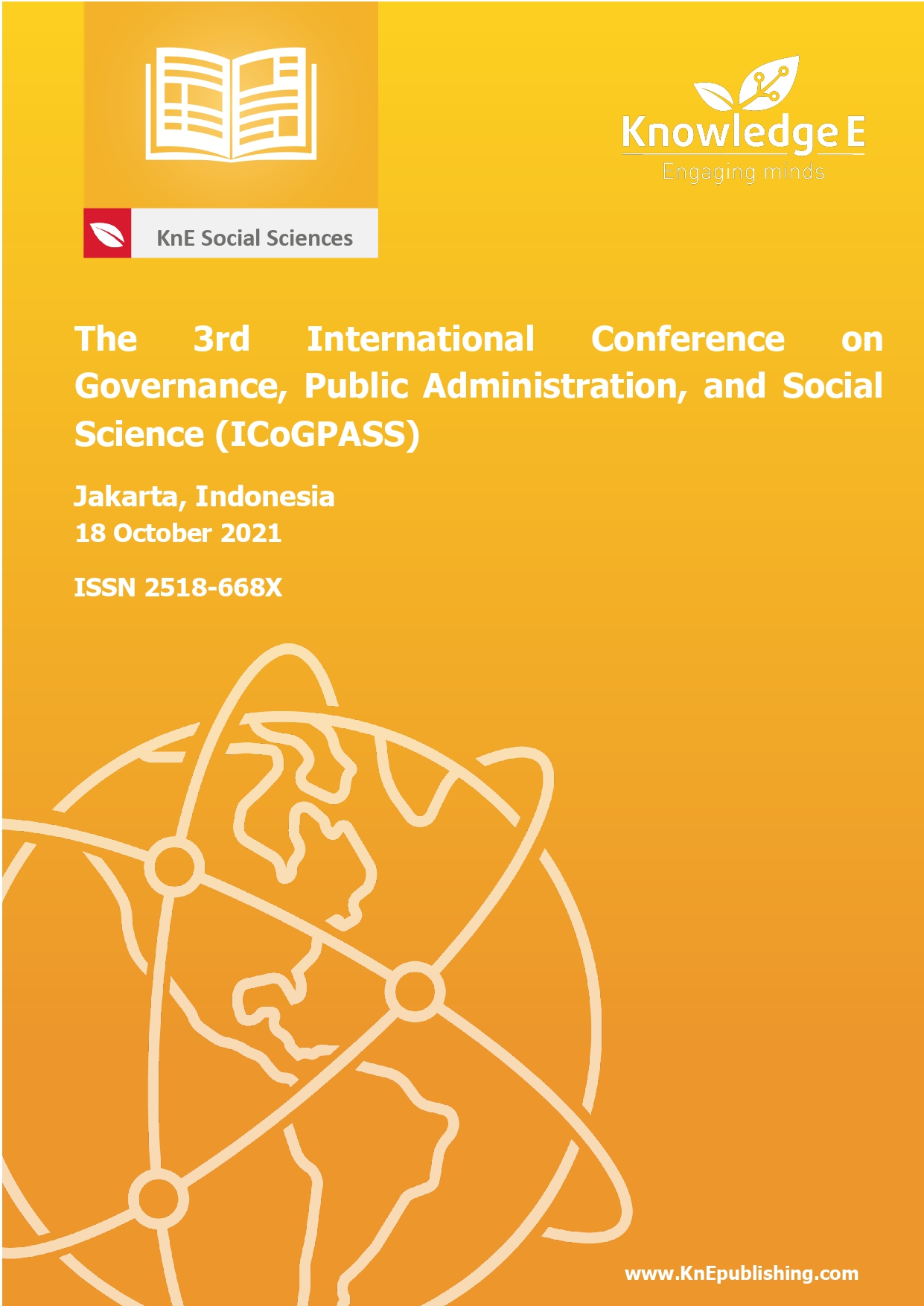The Public Policy Dynamics of Increasing Health Insurance Rates in a Developing Country
DOI:
https://doi.org/10.18502/kss.v7i9.10927Abstract
Health insurance plays an important role in the COVID-19 pandemic. As a part of public policy, examining increasing health insurance contributions in developing countries is important to understand the dynamics, formulation processes, pros and cons, and implications for public participation. This study considered the increasing contributions of Indonesia Health Insurance (BPJS) and the findings indicated that the government faces a dilemma. On one side, the income of citizens is relatively diminished due to the restrictions on mobility as a result of the pandemic. On the other side, during the pandemic, health services need to perform well. Considering that health insurance is part of a national social security system, which is a common feature in developing countries, public health costs should be the responsibility of the State. Therefore, the increase in the BPJS Kesehatan rate needs to consider the ability of the citizen, and also ensure a positive impact on improving health services for the citizen.
Keywords: public policy dynamics, public participation, positive impact
References
Wijaya AF, Hayat A, Sujarwanto. Public policy dynamics. Tangerang Selatan: Universitas Terbuka; 2020.
Kumorotomo W. Envisioning agile government: Learning from the Japanese concept of society 5.0 and the challenge of public administration in developing countries. Advances in Economics, Business and Management Research. 2019;122:144-163.
Fauzi AN, Rostyaningsih D. Strategy for realizing quality health insurance. Journal of Public Policy and Management Review. 2018;7(4):1-18. https://doi.org/10.14710/jppmr.v7i4.22052
Anggara S. Public policy: Bahasa Indonesia. Bandung: CV Pustaka Setia; 2014.
BPJS Kesehatan. History of social security in Indonesia. BPJS Kesehatan; 2020 Dec 2. Available from: https://www.bpjskesehatan.go.id/bpjs/index.php/pages/detail/2013/4
Kementerian Perencanaan Pembangunan Nasional/Badan Perencanaan Pembangunan Nasional. Social protection in Indonesia: Challenges and plans. Jakarta: Direktorat Perlindungan dan Kesejahteraan Masyarakat; 2014.
JKN. Pusat Informasi JKN, Pelaku JKN. Pusat Informasi Jaminan Kesehatan Indonesia; 2021 (NA). Available from: http://jkn.jamsosindonesia.com/jkn/detail/pelakujkn#.YGbRPugzbIV
JKN. Memahami penyelenggaraan JKN. Pusat Informasi Jaminan Kesehatan Indonesia; 2021 (NA). Available from: http://jkn.jamsosindonesia.com/topik/detail/memahami-penyelenggaraanjkn#.YGbnUOgzbIV
Bakarudin FN, Wibawa F, Nggao F et. al. Health insurance in Indonesia history and transformation of BPJS Health. Bahasa Indonesia. Jakarta: BPJS Kesehatan Kantor Pusat; 2020.
World Health Organization (WHO). Tracking universal health coverage: 2017 global monitoring report. Switzerland: WHO; 2017. Available from: https://apps.who.int/iris/bitstream/handle/10665/259817/9789241513555-eng.pdf
WHO. Universal health coverage. WHO. (NA). Geneva, Switzerland. Available from: https://www.who.int/health-topics/universal-health-coverage#tab=tab_1
Putri RN. Comparison of health systems in developing and developed countries. Jurnal Ilmiah Universitas Batanghari Riau. 2019;19(1):139-146. https://doi.org/10.22437/jmj.v7i2.8030
Chongsuvivatwong V, Phua KH, Yap MT et al. Health and health-care system in Southeast Asia: Diversity and transitions. Health in Southeast Asia. 2011;1(377):429- 437.
BPJS Kesehatan. Contribution to handling Covid19. BPJS Kesehatan. (NA). Edition 83. Available from: https://bpjskesehatan.go.id/bpjs/dmdocuments/93e10afefdf9adcd5f8113badeaff6dc.pdf
BPJS Kesehatan. Strategy for realizing quality health insurance. Info BPJS Kesehatan. (NA). Edition 70. Available from: https://bpjskesehatan.go.id/bpjs/dmdocuments/a753991e4646b09e4aaa44108d79c1d8.pdf
Aida CN, Chrisnahutama A. National health insurance deficit ( JKN) proposed alternative for sustainable funding. Policy Brief. PRAKARSA; 2020 May (NA). Available from: http://theprakarsa.org/wp-content/uploads/2020/05/Policy-Brief-22- Defisit-Jaminan-Kesehatan-Nasional-JKN.pdf
Firdaus KK, Wondahio LS. Analysis of health contributions and expenses for evaluation of health insurance programs. Bahasa Indonesia. Jurnal ASET (Akuntansi Riset). 2019;11(1):147-158. https://doi.org/10.17509/jaset.v11i1.16898
Hasibuan R, Purnama TB, Susanti N. Response to increase in national health insurance contributions and health center utility by JKN participants in Medan. Jurnal Kebijakan Kesehatan Indonesia. 2020;9(4):211 - 217. https://doi.org/10.22146/jkki.59237
Wijayanti L, Nur Z, Laraswati D, Pimada LM. Impact of BPJS contribution policy on BPJS users. ISOQUANT: Jurnal Ekonomi, Manajemen, dan Akuntansi. 2020;4(I):58- 68. http://dx.doi.org/10.24269/iso.v4i1.318.g313
Gloria. Increase in BPJS contribution doesn’t guarantee a deficit budget. Universitas Gadjah Mada; 2020 Jun 22. Available from: https://www.ugm.ac.id/id/berita/19599- kenaikan-iuran-bpjs-tak-menjamin-penyelesaian-defisit
BPJS Kesehatan. Management report program & annual financial report 2018 (Audited). Jakarta: BPJS Kesehatan; 2019.
Retnaningsih H. Mencari solusi atas kenaikan iuran BPJS kesehatan 2020. Info Singkat; 2020 Jan (NA). Available from: doi:https://berkas.dpr.go.id/puslit/files/info_singkat/Info%20Singkat-XII-2-II-P3DIJanuari-2020-175.pdf
Kementerian Kesehatan. Bahan paparan jaminan kesehatan nasional ( JKN) dalam sistem jaminan sosial nasional. Jakarta: Kementerian Kesehatan Republik Indonesia; 2013.
BPJS. Management report program & annual financial report 2019. Jakarta: BPJS Kesehatan; 2020. Available from: https://bpjs-kesehatan.go.id/bpjs/arsip/view/1520

